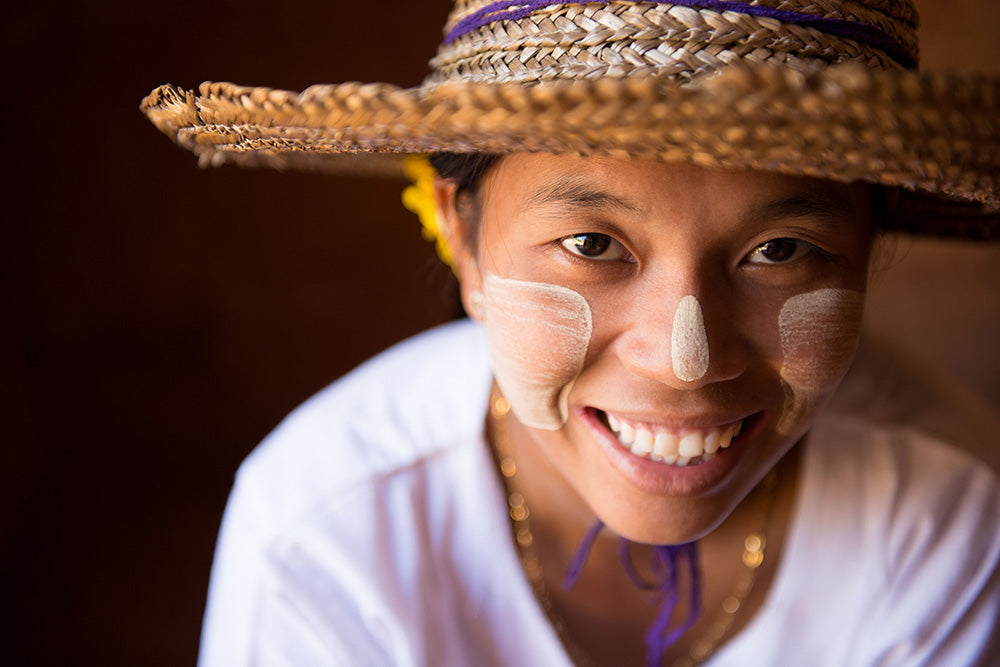Thanaka’s Historical Roots


For many travelers to Myanmar (formerly Burma), the most notable sight is not the exotic landscapes or temples but the yellowish paste found painted on the faces of Burmese women and children. Called thanaka, the paste is applied in circular patches, stripes or ornate leaf patterns on the cheeks, nose, and forehead.
MYANMAR’S SUN PASTE
Thanaka paste is made by grinding the bark and roots of thanaka trees (Limonia acidissima or Hesperethusa crenulata) with water on a stone slab called a kyauk pyin, which has a channel around the rim for the water to drain into. The resulting paste is applied to the face as a natural and efficient sunscreen against the hot tropical sun. For locals, thanaka is an extremely ecological sunscreen solution because of its regenerative nature and the fact that it can be grown locally through sustainable farming techniques.
Thanaka is believed by the Burmese to beautify skin and prevent wrinkles and acne, so it’s also widely used as a cosmetic. Many women apply thanaka every day after their morning shower and again before bed to maximize its effects. Some Myanmar elementary schools even require children to wear thanaka as part of their daily uniforms to show that they’ve bathed. Its sandalwood scent is another reason for its attractiveness, and its cooling sensation makes it ideal to relieve sunburn and insect bites.
Thanaka trees grow abundantly and are used medicinally in other Southeast Asian countries to treat maladies like malaria, epilepsy, leprosy, heart disease and stomach infection. However, only in Myanmar is it used as a daily cosmetic, although this practice has recently been spreading to Thailand. In Burmese culture, its use dates back 2,000 years.
HISTORICAL ROOTS
It’s believed that thanaka use was made popular by a legendary queen of Beikthano, whose envy-inducing skin was attributed to using the paste. However, its history may actually date back to the founding of the country.
The first written reference of its use in Burma is found in a 14th century poem penned by a companion of King Razadarit, who’s famous for reunifying the Mon-speaking regions of southern Burma and considered one of Burma’s greatest monarchs.
Thanaka’s early historic roots were also demonstrated after a 1930 earthquake dismantled the ancient Shwemawdaw Pagoda. From the ruins, a kyauk pyin was found. It was said to belong to a daughter of King Bayinnaung, who ruled from 1550 to 1581 and is known for assembling the largest empire in the history of Southeast Asia.

Photo: Shwemawdaw Pagoda, Creative Commons
AGE-OLD PROCESS
Obtaining thanaka paste is a very long process that speaks to its high value in Burmese culture. Thanaka trees must grow for at least 35 years before they’re considered old enough to produce quality cuttings, as the trees grow slowly and can take 10 years for the trunks to reach just two inches in diameter. Once the trees have grown large enough, they’re cut, and thanaka paste is then ground from the bark or roots.
Traditionally, thanaka is sold from vendors as individual small logs or in bundles to be ground by the purchaser. But because of modern day needs for convenience, pre-ground powders and pastes are now available. However, many Burmese women remain true to its organic form, skeptical of what other ingredients may be mixed into the pre-made products.

Photo: Thanaka Bundles & Kyauk Pyin, Wikipedia Commons
FESTIVAL PASTE
Thanaka has become such an integral part of Burmese culture, it’s even a key ingredient in traditional festival rituals. Each year, Myanmar rings in the start of the new year with a four-day water festival called Thingyan. Rooted around the Buddhist belief that water brings prosperity and happiness, the festival is focused on exchanges of best wishes and splashing water at one another.
During the festival, a traditional thanaka-making event takes place where a group of young women grind thanaka bark and roots into a fine powder. Young men play music and dance, providing entertainment during the event. The ground thanaka powder is dissolved in holy water to create a liquidy paste that’s poured over images of Buddha. Locals then use the leftover water buckets to play and splash each other.

Photo: Thingyan Water Festival, Wikipedia Commons
SYMBOL OF PRIDE
From ancient times to the present, thanaka has played an important role in Burmese culture. Myanmar is an exceptionally diverse country, especially considering its geographical size is comparable to the size of Texas. Its tumultuous, war-stricken history has brought people and cultural influences from over 100 ethnic groups together as one. Although riots between the local Buddhist and Muslim communities are known to occur, thanaka stands as a unifying symbol of cultural pride that is worn by all Burmese people.
Sources:
- http://www.ncbi.nlm.nih.gov/pubmed/24595576
- http://www.nytimes.com/2014/07/29/world/asia/where-ancient-burmese-beauty-balm-competes-with-modern-cosmetics.html?_r=0
- http://www.nationmultimedia.com/travel/Yangon-awash-for-Thingyan-30203711.html
- http://enfo.agt.bme.hu/drupal/en/node/12883
- http://www.minordiversion.com/2012/03/faces-from-myanmar/


